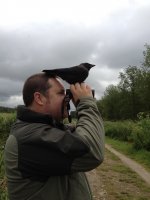stuart white
Well-known member
The Plover came a bit closer this evening, at least better than just a smudge!!
The only features that I can see on this bird that makes it Pacific is the length of the tertials, there is as far as I can see hardly any exposed primary, plus wider black down chest. Otherwise plumage looks very like a American, structure hard to tell on a lone bird but cannot see any difference comparing it to my pics of American.
Any comments??
John
I think there is your answer John with those last shots, the flanks should be solid black on American. The tertials almost cloak the primary tips, you should see 4 clear tips on American. More subjectively the rear end doesn't look as attenuated on this bird compared to the Cley AGP from 09 and the tibia not as long.
I agree on the white neck bulge though, I always thought that was more of an AGP feature, the PGP from Breydon when first seen showed this but appeared to moult during its stay




